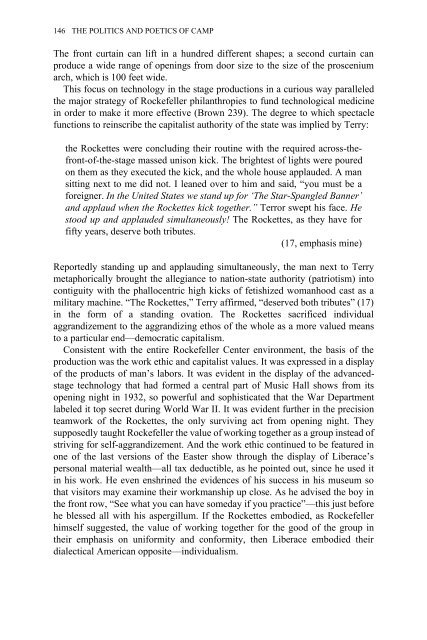Edited by Moe Meyer - Get a Free Blog
Edited by Moe Meyer - Get a Free Blog
Edited by Moe Meyer - Get a Free Blog
Create successful ePaper yourself
Turn your PDF publications into a flip-book with our unique Google optimized e-Paper software.
146 THE POLITICS AND POETICS OF CAMP<br />
The front curtain can lift in a hundred different shapes; a second curtain can<br />
produce a wide range of openings from door size to the size of the proscenium<br />
arch, which is 100 feet wide.<br />
This focus on technology in the stage productions in a curious way paralleled<br />
the major strategy of Rockefeller philanthropies to fund technological medicine<br />
in order to make it more effective (Brown 239). The degree to which spectacle<br />
functions to reinscribe the capitalist authority of the state was implied <strong>by</strong> Terry:<br />
the Rockettes were concluding their routine with the required across-thefront-of-the-stage<br />
massed unison kick. The brightest of lights were poured<br />
on them as they executed the kick, and the whole house applauded. A man<br />
sitting next to me did not. I leaned over to him and said, “you must be a<br />
foreigner. In the United States we stand up for ‘The Star-Spangled Banner’<br />
and applaud when the Rockettes kick together.” Terror swept his face. He<br />
stood up and applauded simultaneously! The Rockettes, as they have for<br />
fifty years, deserve both tributes.<br />
(17, emphasis mine)<br />
Reportedly standing up and applauding simultaneously, the man next to Terry<br />
metaphorically brought the allegiance to nation-state authority (patriotism) into<br />
contiguity with the phallocentric high kicks of fetishized womanhood cast as a<br />
military machine. “The Rockettes,” Terry affirmed, “deserved both tributes” (17)<br />
in the form of a standing ovation. The Rockettes sacrificed individual<br />
aggrandizement to the aggrandizing ethos of the whole as a more valued means<br />
to a particular end—democratic capitalism.<br />
Consistent with the entire Rockefeller Center environment, the basis of the<br />
production was the work ethic and capitalist values. It was expressed in a display<br />
of the products of man’s labors. It was evident in the display of the advancedstage<br />
technology that had formed a central part of Music Hall shows from its<br />
opening night in 1932, so powerful and sophisticated that the War Department<br />
labeled it top secret during World War II. It was evident further in the precision<br />
teamwork of the Rockettes, the only surviving act from opening night. They<br />
supposedly taught Rockefeller the value of working together as a group instead of<br />
striving for self-aggrandizement. And the work ethic continued to be featured in<br />
one of the last versions of the Easter show through the display of Liberace’s<br />
personal material wealth—all tax deductible, as he pointed out, since he used it<br />
in his work. He even enshrined the evidences of his success in his museum so<br />
that visitors may examine their workmanship up close. As he advised the boy in<br />
the front row, “See what you can have someday if you practice”—this just before<br />
he blessed all with his aspergillum. If the Rockettes embodied, as Rockefeller<br />
himself suggested, the value of working together for the good of the group in<br />
their emphasis on uniformity and conformity, then Liberace embodied their<br />
dialectical American opposite—individualism.


